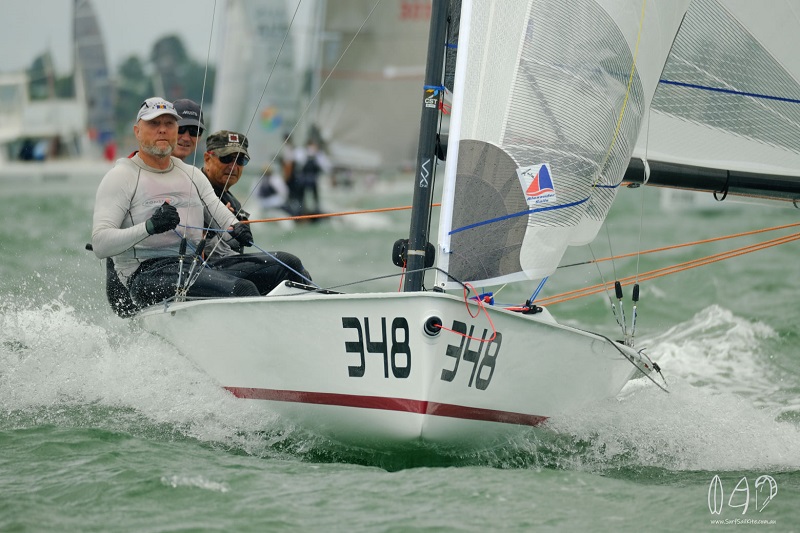

In the sport of sailing, there are plenty of myths and I have attempted to set out below some of the most common ones with the correct answers that debunk them.
1. MYTH – To determine the favoured end of the starting line, go to the middle of the line and point straight into the wind, the end of the line that your bow is pointing to is the end that is favoured.
TRUTH – This will show you which end is further upwind but it is not necessarily the end that is favoured. The favoured end of the starting line is the one that will get you to the windward mark sooner, taking into account a number of strategic and tactical factors including which end is farther upwind and by how much. You must also take into account wind shifts, pressure, current, waves and location of the first mark.
2. MYTH – The best way to stay in front of another boat is by tacking ahead and to windward of them.
TRUTH – The most common reason why a boat gets passed on a beat is that she lets the boat behind go too far away and then there is a wind shift. The idea, when you are protecting a lead, is to minimize the leverage or separation, between you and the boat behind so that, even if the wind shifts in their favour, they won’t gain enough to pass you. We have all been told that the best way to do this is to tack directly upwind of the other boat. But think about that – if you tack on another boat’s wind, they will tack right away and then the distance between boats will be increasing.
3. MYTH – In an oscillating breeze, wait for the maximum header that you expect and then tack.
TRUTH – Tacking on headers is the right strategy, but don’t wait until you are headed all the way. Tack when you are headed to your median course. When racing in an oscillating breeze, the goal is to sail on the lifted tack and avoid sailing on the headed tack as much as possible. That’s why you should tack when you are headed – so you can sail a lift on the other tack.
4. MYTH – Pull your cunningham tight enough to remove horizontal wrinkles along the luff of the mainsail. Sails are designed to be smooth, so use your Cunningham to achieve this shape.
TRUTH – The purpose of the cunningham is primarily to control the fore-and-aft position of the draft and the fullness of the sail. It is not intended for getting rid of wrinkles. The most important thing about trimming your mainsail is to make sure it has the right shape for the wind and wave conditions in which you are racing. It is almost always better to
have the right sail shape with a few wrinkles than to make the sail look cosmetically perfect but have a slower shape.
5. MYTH – When sailing upwind, never trim the sheet or traveller so
the boom is higher than the centerline.
TRUTH – Many racing boats sail very fast upwind with their booms above the centreline, so experiment with this. This works best in lighter air when you need a decent amount of twist in the sail. By pulling the boom to windward, you get enough twist with most of the sail close to the centreline. As the wind comes up and you trim the main harder with less twist, start dropping the boom. If you keep it above centreline, too much of the sail may be on the windward side of the boat creating drag.
6. MYTH – When sailing upwind in waves, you should position your crew weight as close together as possible near the middle of the boat.
TRUTH – It may actually be faster when racing upwind in waves, to
spread your weight out a bit fore and aft. Squeezing your crew weight together in the middle of the boat is a good idea and you should try that. Sometimes, even when you have your weight as close together as possible, the boat still seems to pound. If this happens, it could be that your weight distribution is not optimized
for the frequency of the waves. Try moving farther apart and test different distances and see which arrangement minimizes hobby-horsing.
7. MYTH – It’s fine to leave the jib sheet cleated most of the time while you are racing upwind.
TRUTH – You would never cleat the spinnaker sheet while you are racing. For for the same reason you should not cleat the jib sheet nor the mainsheet for that matter. The wind and waves are always changing, so to keep going fast you must continually change your sail trim to match the new conditions. You can’t do this if your sheets are cleated.
8. MYTH – In order to get mark-room, you have to hail for room at the mark.
TRUTH – There is absolutely no requirement in the rules for a hail in order to get mark-room. Hailing for room at the mark is a common misunderstanding. There is some logic in expecting an inside boat to hail for mark-room when they are entitled to it. The rules don’t require this. Instead, they say simply that the outside boat must give mark-room to the inside boat.
#sailingtowin #sailing #sailtowin #yachtracing #sailingcoach #Sailboatrace


